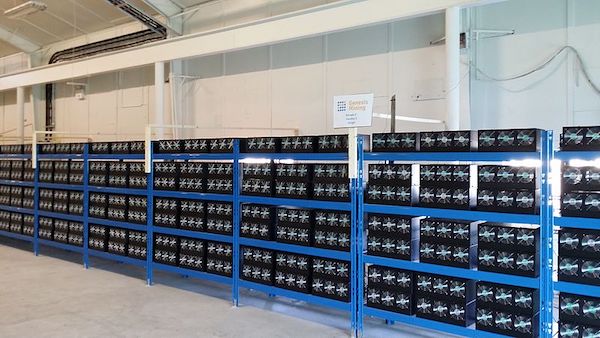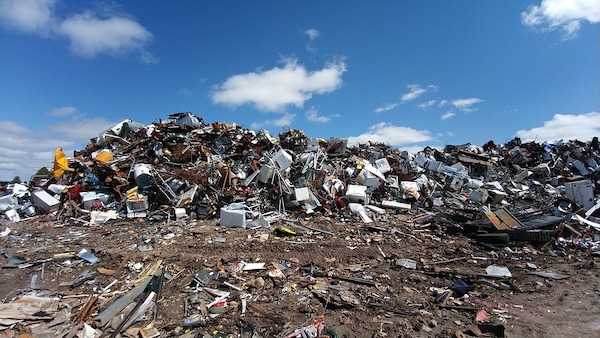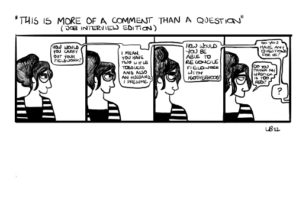I started my journey with cryptocurrencies and blockchains as a Bitcoin miner in early 2013 (DuPont 2014). At the time there were few other ways to actually get Bitcoins, since online cryptocurrency exchanges were nascent and sketchy (and most proved fateful: early exchanges were hacked, bankrupted, or disappeared with customer funds). If you lived in a major city, local meetups or Craigslist hookups were an option, but these had their own kind of unsavoriness. I had an incentive to mine too. I knew that mining used electricity, but my office at the University of Toronto came with “free” electricity. So, in Marshall McLuhan’s old office in the historic Coach House in downtown Toronto, I set up an aging, 2008 Mac Pro workstation on a quest to mine Bitcoins. It felt right mining Bitcoins in McLuhan’s old office—doing my part to produce new, blockchain media.
With the Mac Pro at full “office heater” speed, I set off for riches.
I was able to mine thirty thousand hashes per second with the central processing unit (CPU), a server-grade Intel Xeon chip. But this initial attempt was already out of date; as interest in Bitcoin had surged through 2013, CPU mining had become too slow to be practical. A few weeks later, my second attempt involved a new, midrange gaming graphics card that I bought for a few hundred dollars. Online research suggested that the AMD card I selected was ideal for Bitcoin mining, and a good compromise between price and performance. Plus, the card looked cool with its copper piping, edgy “gamer” graphics, and massive fan. With their 2.15 billion transistors, these cards were built for the demanding task of rendering millions of polygons for video games, but people quickly realized that they also excelled at running the SHA256 hash algorithm for Bitcoin mining. Using the graphics processing unit (GPU) on the card, with my second attempt I had transformed into a real wildcat Bitcoin miner. My machine was capable of turning out a respectable 350 million hashes per second.
Alas, my Bitcoin mining experiment did not last long. In the mining pool I had joined, I earned a half a Bitcoin, then valued at about US $10. Soon GPU mining was also too slow to be practical (even with free University of Toronto electricity). Specialized field-programmable gate array (FPGA) cards, once reserved for high performance supercomputing tasks, were becoming commercially available. These specialized cards did more with even less—their re-programmable chips stripped computing down to the very basics of crunching through hashes. But even the era of FPGA mining was shortlived. Since Bitcoin mining was proving so lucrative, companies began fabricating tailor-made chips that were designed to do only one thing: run the SHA256 hash as fast as possible for the sole purpose of mining Bitcoin. These Application-Specific Integrated Circuits (ASICs) were soon at the cutting edge of chip design, using the smallest (and therefore most efficient) fabrication processes available and iterating the chip design dozens of times per year. Today, these are among the fastest and most efficient chips in the world.
My experience mining Bitcoin revealed that the “mining” metaphor is real. It was hot and used a lot of energy. Originally, the mining metaphor was a commentary on the metallist economic theories associated with Bitcoin (Maurer et al. 2013). Goldbugs loved that Bitcoin had a monetary cap and was scarce, so naturally the production process was called mining. But as my experience showed, it was not long before the metaphor took on a new meaning. Of course, computing has always had an important if underappreciated materiality. Reflecting on the parallels between early computing and Bitcoin mining, Finn Brunton (2015) writes, “as a practical matter, the work of computation is the work of managing heat.” Brunton notes that the UNIVAC was hot and loud and that the EDVAC’s 3,000 vacuum tubes required as much electricity for cooling as for operation. In hot Princeton summers the EDVAC facility resembled a ship’s boiler room. Every computer since has had to deal with thermal management, from CPU bonding glue to my GPU’s copper piping. Early wildcat Bitcoin miners complained about sweltering heat in the summers and the dangers of their ad hoc “fire trap” mining rigs (Gerard 2017). In the winter, miners enjoyed their money-making heaters. Once small-scale wildcat mining became too dangerous and unprofitable, Bitcoin mining shifted to industrial-scale operations in cool locales with cheap hydroelectric power, such as Iceland, Finland, Sweden, and the American Pacific Northwest (Brunton 2015). More recently, Bitcoin mining has shifted to China, where cheap, government-subsidized electricity from imported Australian coal is plentiful—and a serious environmental issue.

Image by Marco Krohn (Wikimedia Commons, CC BY-SA 4.0).
Zac Zimmer (2017) makes a comparison to the environmental impact and exploitive labor practices of early modern silver mining at Potosí in colonial South America. At Potosí, wildcat surface mining using the guayra furnace quickly gave way to a mercury-laden process that ingested great swaths of the Cerro Rico mountain and left toxic tailings behind. The transition to industrial scale was required by Spanish colonists, who would not accept dwindling profits as the easy silver dried up; to improve profits further, the Spanish drafted indigenous laborers (mita). The clear parallel today can be found in China, with its massive Bitcoin mining facilities (one half of the ten largest Bitcoin mining pools are operated in China). The single dominant producer of Bitcoins in China is Bitmain, which fabricates and sells ASICs and runs its own mining facilities. At the end of 2017, Bitmain was directly responsible for 25 percent of all Bitcoin mining. The scale of Bitmain’s operations are breathtaking: in a single mining facility in Ordos, China, Bitmain is responsible for 4 percent of global production. In the facility sit 21,000 mining machines in a constant state of upgrade and repair, serviced around the clock by workers who live on premises (a step up, in pay at least, from the early 2000s when young Chinese men worked long hours farming virtual gold in World of Warcraft; see Bronk, Monk, & Villasenor 2012). Each one of the 21,000 machines produce 14 trillion hashes per second from 189 ASICs. That’s a boggling rate of computation. An identical story can be told at any of Bitmain’s other facilities in China, or Bitfury’s equally massive operations in the Republic of Georgia, or in rentable cloud mining facilities around the globe.
Zimmer (2017) argues that, just as the colonial Spanish terraformed South America, returning to metaphor, these Bitcoin mining facilities are “cryptoforming” the Internet.
There is no doubt that the environmental impact of Bitcoin mining is massive—the physical size of these facilities does not lie—but just how bad is it? In recent years the environmental impact of Bitcoin mining has become a hot-button issue within the community. With no clear way to accurately assess the electricity use or resources needed for Bitcoin mining, critics have offered measurements that highlight waste and environmental impact. It has been suggested that Bitcoin mining uses more electricity than Iceland (17 TWh), Ireland (24 TWh), or Denmark (32 TWh) (2014 figures) (T. B. Lee 2017; O’Dwyer & Malone 2014). One estimate taking into consideration a range of factors pegs Bitcoin’s electricity consumption at 44 TWh in early 2018 (“Bitcoin Energy Consumption Index,” n.d.). Another posits that Bitcoin might use more electricity than electric cars (Loh & Tomesco 2018), or that a single Bitcoin transaction uses more electricity than the average American house in a week (Malmo 2017). But supporters fire back. They point out that traditional money and payment systems use electricity too: to keep the lights on in banks, to melt coins, to run ATMs and point of sales machines, and so on. They also critique the math used by the critics. One thorough debunking pegs the lower bounds for the electricity consumption of Bitcoin at “only” 2.85 TWh in March 2017 (one-sixth of Iceland’s electricity consumption). When the next market run on Bitcoin occurs, it is likely that Bitcoin electricity consumption will increase by several factors, putting it back in striking range of Iceland’s consumption, or worse.
Cryptocurrencies are wasteful for two reasons: 1) distributed and replicated transactions are redundant, and 2) the mining difficulty that correlates to price is an arbitrary activity and purposefully wasteful (as the price rises, miners are incentivized to increase their capital input).
The first, the waste caused by redundancy in cryptocurrency infrastructure, is comparatively miniscule. This is also why the energy-use defense mounted by Bitcoin advocates runs hollow; the electricity needed to run a brick and mortar bank or maintain redundant financial transactions across the globe is a rounding error in the face of “useless” proof-of-work mining. The second, the waste caused by mining, is key to the design of proof-of-work mining and is therefore an unavoidable and morally reprehensible ecological travesty. Unfortunately (for the global environment), the proof-of-work consensus protocol is responsible for features essential to the system: incentivizing transaction validation, issuing tokens, securing the network, preventing spam, and so on. For cryptocurrencies using the proof-of-work consensus protocol, wasteful mining is a necessary consequence. Put simply, there is no Bitcoin without massive energy use and environmental impact.
In any manufacturing environment (virtual or not), optimization and specialization tend towards industrialization. In hindsight, it should have been obvious to everyone that Bitcoin’s unique manufacturing process would end up with acres of specialized machines burning dirty coal, but at the time, the vision was wildcat mining. Much like the dedicated software developers working for free to code open source software, the hope was that interested people would fire up mining software on their home computers. These miners would be building the infrastructure of a new kind of decentralized money, and rewarded a little for their time, effort, and electricity bill. As my mining experience made clear, however, it wasn’t long before this dream faded. The success of Bitcoin meant that real money could be made, which kicked off a rapid process of innovation and capital investment. Unlike typical innovation spirals, the product that resulted was so specialized and under so much competitive pressure that obsolescence was an innate feature. Today, with rapidly plunging Bitcoin prices the opposite has occurred: it no longer makes sense to keep older-model mining equipment running, so now those acres of machines are heading to the landfill.

Image courtesy of pixabay.com.
There are, however, less wasteful alternatives. Bitcoin uses a proof-of-work mining algorithm called “scrypt,” which is particularly susceptible to optimization and specialization. Even though ASICs are vastly more energy efficient than CPUs and GPUs (in terms of hashes per joule), their specialized nature has created perverse incentive dynamics in the cryptocurrency mining industry. Other proof-of-work mining algorithms attempt to prevent industrialization (and the centralization that comes with it) by making mining a general-purpose computing problem, which cannot be optimized. For instance, Ethereum’s ethash mining algorithm requires significant memory, unlike Bitcoin’s scrypt algorithm, so lean ASICs cannot compete. To mine Ethereum today, the best hardware is a beefy video card with a fast GPU and plenty of memory (until optimized hardware—already rumored to exist—is developed).
Because of the diversity of other cryptocurrencies that can be mined using commercially available, desktop hardware, wildcat mining has returned to the fringes of cryptocurrencies. This too, however, has had perverse and unexpected effects. Through 2017 and 2018 wildcat mining of “alt coins” became so prevalent that GPU manufactures could not produce cards quickly enough to satisfy market demand. Consequently, the gamers who traditionally purchase these high-end cards complained about empty shelves and rising prices. Gamers were being priced out by the voracious demand of cryptocurrency miners.
But just a year later, with crashing prices in 2019, these same machines are being scrapped or sold on secondary markets, since it is no longer profitable to run them (in the market for a well-used graphics card?).
Ultimately, wildcat mining is still wasteful, so alternative proof-of-work mining algorithms do not fix the environmental issue. The only real solution (short of prices dropping and staying at a level that makes industrial mining unattractive) is a move away from the inherently wasteful proof-of-work algorithm. There are a few proposals for alternative consensus protocols that keep the network secure without wasteful mining. Intel’s proof-of-elapsed-time technique skips the wasteful work requirement and focuses on the true goal of consensus mechanisms, of making computation take time. Using this consensus protocol, the lottery system relies on the secure computing environment provided by tamper-resistant Intel chips. The downside is that the protocol is vendor-specific.
A more ambitious alternative consensus protocol is being developed by the Ethereum community. Instead of relying on computational work or special hardware, Ethereum is attempting to develop a game-theoretical solution known as proof of stake (dubbed “Casper”). On this model, consensus and security are achieved by requiring miners to make a “stake” in the network—by putting money (ethers) on the line, miners are disincentivized to cheat (if caught cheating they lose their stake). The challenge for the proof of stake consensus model is that it is not really an engineering challenge. Proof of stake requires getting right a complex set of human and social motivations and behaviors. A version of this approach has already been deployed for closed networks with known participants that have existing relationships of trust (Ripple, for example, relies on a reputational model to accomplish consensus and honesty among corporate partners), but it is not yet clear that a general solution for open networks is possible. Until this next generation technology arrives, and we’ve somehow figured out the complex set of social incentives and prohibitions, the dreams of the monetary revolution will remain a hot nightmare.
References
“Bitcoin Energy Consumption Index.” n.d. Digiconomist. Accessed June 14, 2017. http://digiconomist.net/bitcoin-energy-consumption.
Bronk, Christopher, Cody Monk, and John Villasenor. 2012. “The Dark Side of Cyber Finance.” Survival 54 (2): 129–42. https://doi.org/10.1080/00396338.2012.672794.
Brunton, Finn. 2015. “Heat Exchanges.” In MoneyLab Reader: An Intervention in Digital Economy, edited by Geert Lovink, Nathaniel Tkacz, and Patricia de Vries, 158–72. IMC Reader 10. Amsterdam: Institute of Network Cultures.
DuPont, Quinn. 2014. “The Politics of Cryptography: Bitcoin and the Ordering Machines.” The Journal of Peer Production 1 (4): 1–29.
Gerard, David. 2017. Attack of the 50 Foot Blockchain: Bitcoin, Blockchain, Ethereum and Smart Contracts.
Zimmer, Zac. 2017. “Bitcoin and Potosí Silver: Historical Perspectives on Cryptocurrency.” Technology and Culture 58 (2): 307–34. https://doi.org/10.1353/tech.2017.0038.
Lee, Timothy B. 2017. “Bitcoin’s Insane Energy Consumption, Explained.” Ars Technica (blog). December 6, 2017. https://arstechnica.com/tech-policy/2017/12/bitcoins-insane-energy-consumption-explained/.
Loh, Tim, and Frederic Tomesco. 2018. “Bitcoin Could End Up Using More Power Than Electric Cars.” Bloomberg.Com, January 10, 2018. https://www.bloomberg.com/news/articles/2018-01-10/bitcoin-outshines-electric-cars-as-driver-of-global-power-use.
Malmo, Christopher. 2017. “One Bitcoin Transaction Now Uses as Much Energy as Your House in a Week.” Motherboard (blog). November 1, 2017. https://motherboard.vice.com/en_us/article/ywbbpm/bitcoin-mining-electricity-consumption-ethereum-energy-climate-change.
Maurer, Bill, Taylor C. Nelms, and Lana Swartz. 2013. “‘When Perhaps the Real Problem Is Money Itself!’: The Practical Materiality of Bitcoin.” Social Semiotics 23 (2): 261–77. https://doi.org/10.1080/10350330.2013.777594.
O’Dwyer, Karl J., and David Malone. 2014. “Bitcoin Mining and Its Energy Footprint.” In . Limerick, Ireland. http://digital-library.theiet.org/content/conferences/10.1049/cp.2014.0699.
Excerpted from Cryptocurrencies and Blockchains (Polity 2018)
Featured image by Dieter R (flickr, CC BY 2.0).









